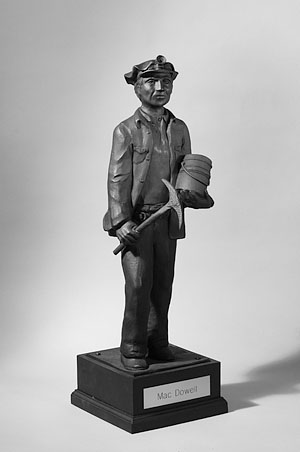
“Mac Dowell,” a 27-inch-tall coal
sculpture from Coal Camp Creations in Kimball, McDowell County. Photograph
by Michael Keller.
Coal Art
The Other West Virginia Coal Industry
By Jean Battlo
When U.S. President Lyndon B. Johnson declared a War on Poverty, West Virginia became a central front. The many antipoverty programs at that time included a concerted effort to support arts and crafts in the state. It was fortuitous that the director of the arts and crafts division of the West Virginia Department of Commerce was Donald L. Page, now retired and living in Beckley. All of us who know that grand old man are familiar with the story of how he became the unsuspecting commander in the war. [See “Hearth & Fair: Don Page and the Roots of GOLDENSEAL,” by John Lilly; Spring 2004.]
Under an economic umbrella provided by the U.S. Department of Commerce, Page spearheaded the Arts and Crafts Technical Assistance Demonstration Project. It was in this official position that he got the idea of making arts and crafts from coal.
“It was during the Christmas of 1963,” Don recalls. “Unemployment was a very serious problem in West Virginia and elsewhere. I had the responsibility of trying to do something about this for artists and craftsmen, to come up with something that was both appealing and had marketability.”
Page already had a background in mold making and plastics when he was sent to Stotesbury, Raleigh County, to “come up with something unique.” Located on Winding Gulf, Stotesbury was named for E.T. Stotesbury, who along with E.E. White, operated the mines there until they were purchased by the Koppers company in the 1930's. The history of the mines’ decline is well known, and the resulting poverty and unemployment has been well recorded. From this atmosphere and using the available natural resources, Page formed the unique craftsmanship of coal figurines.
“I developed a medium that was about 55 to 60% coal dust and 45% polyester,” Don says. “There was already some coal jewelry being made, but coal figurines were a new West Virginia concept. I went to Steve Turkovish, a wood carver from Kanawha County, and we started with three characters: a coal miner, a lumberjack, and a railroad engineer.”
As this second coal industry developed, Page taught others and helped establish small cottage industries around the state. At Cass, cinders from the railroads were used in developing figurines germane to the railroad industry. In time, these West Virginia programs extended beyond the state, as Don Page was influential in helping establish several coal-figurine businesses in neighboring states.
During the two decades following Don Page’s initiation of the project, several new artisans took up the tools. In 1980, Mary Dell Carter of Alderson decided to open a shop. She called it C&C Crafts, short for “Carter & Carter Crafts,” in hopes that the enterprise would become a family business. Some of the Carters were miners, so Mary had a respect for the coal industry. She hoped her new business would solidify her familial ties.
Sharon Altizer, heiress to her grandmother’s vision, is the artisan at C&C Crafts today. Sharon notes that Mary Carter’s plan was successful and that Mary’s children and grandchildren have participated in the business’ success over the past two-and-a-half decades.
Sharon writes of her initial reaction to her grandmother’s plans, “I myself remember the day she told me she was going to make coal jewelry. In my 10-year-old mind’s eye were big Flintstone like hunks of coal beaded around some poor, unsuspecting woman’s neck like a dog collar. Ick! Nobody will ever want that!”
Acknowledging the immaturity of her own initial vision, Sharon recalls that her mother and grandmother began to develop beautiful jewelry of the best quality they were capable of making.
You can read the rest of this article in this issue of Goldenseal, available in bookstores, libraries or direct from Goldenseal.